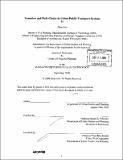| dc.contributor.advisor | Karen R. Polenske. | en_US |
| dc.contributor.author | Guo, Zhan, 1973- | en_US |
| dc.contributor.other | Massachusetts Institute of Technology. Dept. of Urban Studies and Planning. | en_US |
| dc.date.accessioned | 2009-04-29T17:36:20Z | |
| dc.date.available | 2009-04-29T17:36:20Z | |
| dc.date.copyright | 2008 | en_US |
| dc.date.issued | 2008 | en_US |
| dc.identifier.uri | http://hdl.handle.net/1721.1/45401 | |
| dc.description | Thesis (Ph. D.)--Massachusetts Institute of Technology, Dept. of Urban Studies and Planning, 2008. | en_US |
| dc.description | Includes bibliographical references (p. 285-294). | en_US |
| dc.description.abstract | Transfers are endemic in public transport systems. Empirical evidence shows that a large portion of public transport journeys involve at least one change of vehicles, and that the transfer experience significantly affects the travelers' satisfaction with the public transport service, and whether they view public transport as an effective option. Despite their importance, however, transfers have long been overlooked by decision-makers, transportation planners, and analysts. Transfer-related research, practice, and investments are rare compared with many other aspects of transportation planning, probably because (1) the underlying transfer behavior is too complex; (2) the analysis methods are too primitive; and (3) the applications are not straightforward. This dissertation focuses on these issues and contributes to current literature in three aspects: methodology development, behavior exploration, and applications in practice. In this research, I adopt a path-choice approach based on travelers' revealed preference to measure the disutility associated with transfer, or the so-called transfer penalty. I am able to quantify transfer experience in a variety of situations in great spatial detail, and reduce the external "noises" that might contaminate the model estimation. I then apply the method to two public transport networks: a relative small and simple rail network (subway and commuter rail) in Boston and a large and complex network (Underground) in London. Both networks offer a large variability of transfer environment and transfer activities. Estimation results show high system-wide transfer penalties in both studies, indicating that transfer experience can have a very negative impact on the performance and competitiveness of public transport. They also suggest that the system-average value has limited applications in planning and operation because the transfer penalty varies greatly across station and movement. Such variation is largely caused by different transfer environments, not by different personal characteristics, attitudes, preferences, or perceptions, at least in the two investigated networks. | en_US |
| dc.description.abstract | The two applications to the London Underground network illustrate that the lack of careful consideration of transfer effect can lead to inaccurate passenger flow estimation as well as less credible project evaluation and investment justification. The results further confirm the potential, as well as the importance, of transfer planning in major multimodal public transport networks. | en_US |
| dc.description.statementofresponsibility | by Zhan Guo. | en_US |
| dc.format.extent | 294 p. | en_US |
| dc.language.iso | eng | en_US |
| dc.publisher | Massachusetts Institute of Technology | en_US |
| dc.rights | M.I.T. theses are protected by
copyright. They may be viewed from this source for any purpose, but
reproduction or distribution in any format is prohibited without written
permission. See provided URL for inquiries about permission. | en_US |
| dc.rights.uri | http://dspace.mit.edu/handle/1721.1/7582 | en_US |
| dc.subject | Urban Studies and Planning. | en_US |
| dc.title | Transfers and path choice in urban public transport systems | en_US |
| dc.type | Thesis | en_US |
| dc.description.degree | Ph.D. | en_US |
| dc.contributor.department | Massachusetts Institute of Technology. Department of Urban Studies and Planning | |
| dc.identifier.oclc | 317408515 | en_US |
